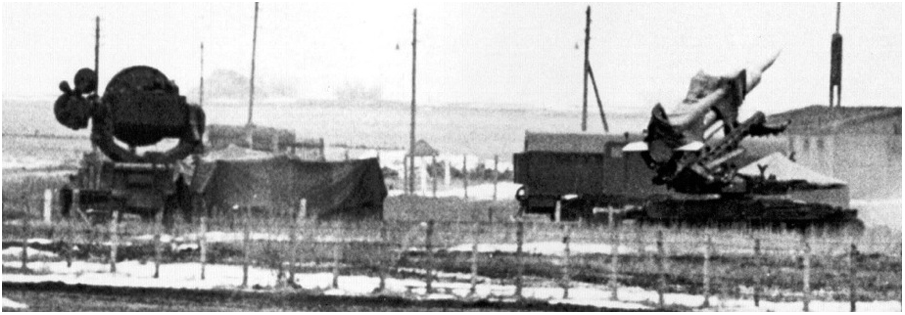
 Paul Nikulla served at the United States Military Liaison Mission (USMLM) as an Air Team tour officer between 1967 and 1971.
Paul Nikulla served at the United States Military Liaison Mission (USMLM) as an Air Team tour officer between 1967 and 1971.
He remembers for us the first USMLM coverage of the SA-4 and its associated equipment
during a deployment at Cochstedt in 1970.
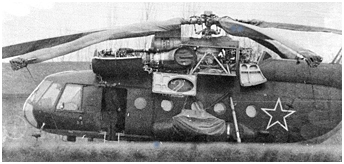
 A l'époque du récit, Cochstedt n'était pas encore situé dans une ZIP, contrairement à ce qui
figure sur cette carte. © USMLM.
A l'époque du récit, Cochstedt n'était pas encore situé dans une ZIP, contrairement à ce qui
figure sur cette carte. © USMLM.
At the time of this story, Cochstedt was not yet inside a PRA, contratry to what appears
on this map. © USMLM.
Cochstedt was a deployment airfield. When the field was vacant we would periodically drive the runway at high speeds to check its condition.
The field was regularly occupied by 'Fishbed' (MiG-21) aircraft and on one occasion, we had the opportunity to observe a 'Hip-C' helicopter with
its access panels opened for repairs.
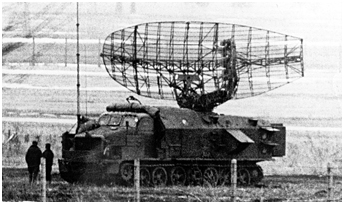 Cochstedt was not yet in a permanent restricted area (PRA) in 1970 when,
acting on a tip off from a usually reliable source that some unusual activity was taking place on the field, we scheduled our first
visit of this series to the field. The sighting of the 'Long Track' target acquisition radar was the tell tale indicator that something new was
being deployed. The 'Long Track' was first sighted at the Pritzwalk radar site. At that time only the sail of the radar antenna was visible.
The tracked vehicle was obscured by other equipment. On the Cochstedt field, the 'Long Track' was out in the open with Soviet troopers standing
around the tracked vehicle. A telescoping omni-directional VHF/UHF antenna was located to the front of the 'Long Track'.
Cochstedt was not yet in a permanent restricted area (PRA) in 1970 when,
acting on a tip off from a usually reliable source that some unusual activity was taking place on the field, we scheduled our first
visit of this series to the field. The sighting of the 'Long Track' target acquisition radar was the tell tale indicator that something new was
being deployed. The 'Long Track' was first sighted at the Pritzwalk radar site. At that time only the sail of the radar antenna was visible.
The tracked vehicle was obscured by other equipment. On the Cochstedt field, the 'Long Track' was out in the open with Soviet troopers standing
around the tracked vehicle. A telescoping omni-directional VHF/UHF antenna was located to the front of the 'Long Track'.
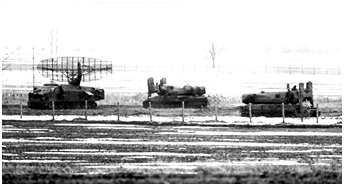
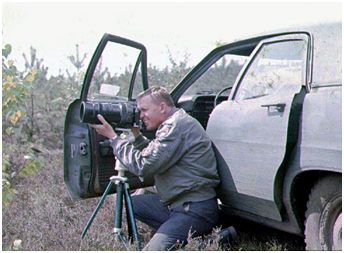 Paul Nikulla en action avec un téléobjectif soviétique de 1000 mm. © P.Nikulla.
Paul Nikulla en action avec un téléobjectif soviétique de 1000 mm. © P.Nikulla.
Paul Nikulla in action, using a Soviet made 1,000 mm lens. © P.Nikulla.
This appeared to be a training exercise/field deployment (1) of the new SA-4 'Ganef' SAM system.
To get as complete coverage of the deployment as possible,
multiple visits were made to the field by myself and Captain Igor Vichnevsky. To avoid detection by MfS (or the 'Narks') (2).
surveillance, it was necessary to
vary the routes into the area. Sometimes we would go way south and west of Cochstedt and then work our way back up using very cicuitous routes.
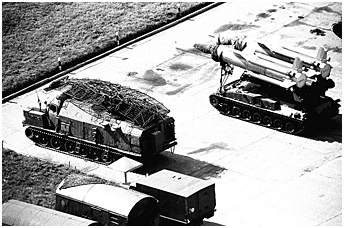 Other times we would head east of the field then come back using back roads littled traveled, avoiding cities and larger towns.
I don't recall the exact number of visits we made to the field during this deployment, but it was almost daily for a period of ten days to two weeks.
Strange as it may seem, we encountered no active nark or Soviet military patrol surveillance at any time during this period. It almost seemed that the Soviets might
have been demonstrating this new SAM to impress us. My best observation points (OPs) were on the western perimeter of the field. There was enough cover
and clear line of sight views of the activity.
Other times we would head east of the field then come back using back roads littled traveled, avoiding cities and larger towns.
I don't recall the exact number of visits we made to the field during this deployment, but it was almost daily for a period of ten days to two weeks.
Strange as it may seem, we encountered no active nark or Soviet military patrol surveillance at any time during this period. It almost seemed that the Soviets might
have been demonstrating this new SAM to impress us. My best observation points (OPs) were on the western perimeter of the field. There was enough cover
and clear line of sight views of the activity.
The best photography of the equipment was made with the Soviet made 1,000 mm MTO catadioptic (folded mirror)
lens with the Nikon F camera with a motor drive using a tripod for stability.
| The 2K11 SAM system |
| Cochstedt Airbase Cochstedt was occupied by the US Army in April 1945 and transferred under Soviet control in July. A 2200 X 50 meters hard runway, taxiways and two flightlines were built between April an December 1958. The runway length was increased to 2500 meters from July to September 1965. Yak-11, Yak-18, Li-2 and Il-12 would have been based there during the fifties. The Yak-11 would have been used to intercept spy balloons drifting from the West. Numerous fighter, fighter-bomber and reconnaissance units were regularly deployed at Cochstedt during the sixties until the early eighties. Helicopter detachments took place there as well. PSP dispersals for helicopters were built at the west-end of the airfield in 1985. The 292.OVE REB moved indeed in May from Allstedt with its Mi-8PPA and its Mi-8SMV to be based permanently at Cochstedt. That separate electronic warfare helicopter squadron had previously migrated from Berdyansk (Zaporozhie region in Ukraine), where it was formed between 1979 and 1981, to Allstedt in 1981. The transit flight went through Romania, Brzeg in Poland and Altes Lager. Like the two other helicopter units directly subordinated to the 16.VA HQ (the 113.OSAE and the 239.OGVP), the helicopters of the 292.OVE REB were never part of the Army Aviation but subordinated to VVS structures. On 7 July 1992, the squadron was rapatriated to Alabino in the Moscow region close to Kubinka, where the unit joined the Mi-8 and the Mi-24V of the local 297.OVE that became on that occasion an OVE REB. From Rote Plätze by S.Büttner & L.Freundt and Oleg Grab. |
notes
(1)
It is quite possible that Cochstedt was the home of a SAM battery used for training purposes that was activated from time to time when necessary.
This battery could have come from the 49th Anti-Aircraft Missile Brigade (ZRBR) stationed in Planken (Colbitz), which consisted of three sections based
at Colbitz, Bernburg and Quedlinburg-Quarmbeck. According to the book 'Rote Plätze' by Stefan Büttner and Lutz Freundt, it would appear that such training sections
existed at least at Zerbst (SA-6) and Falkenberg.
(2)
MfS: Ministeriums für Staatssicherheit (Ministry for State Security, better known as Stasi) whose personnel was nicknamed 'narks' by the USMLM.
 |
Plan du site - Sitemap |  |

